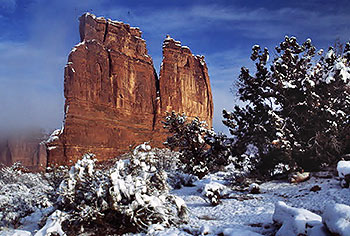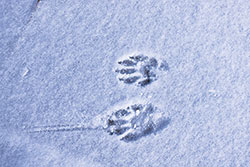 Winter is the quiet time in Canyon Country. Often snow and ice prohibit or at least make it difficult for hikers to explore the landscape. These challenging conditions reduce the amount of traffic in and around the region but for the area wildlife, it’s “status as normal.”
Winter is the quiet time in Canyon Country. Often snow and ice prohibit or at least make it difficult for hikers to explore the landscape. These challenging conditions reduce the amount of traffic in and around the region but for the area wildlife, it’s “status as normal.”
Some species of wildlife such as bears, marmots, ground squirrels, reptiles, and amphibians choose to ride out winter in deep slumber. Ectotherms, those that depend upon an external heat source for their metabolism to function, have slithered or crawled into a protective den or confine before the onset of winter. Though you might notice a small side-blotched lizard scurrying about on a warm winter day, it’s a rare event. The lizard’s small size enables it to warm up faster than some of the larger lizards or snakes, but they may retreat to a protective area if the temperatures drop.
Marmots and some other small mammals go into hibernation early in the fall and don’t emerge until spring. One small mammal in the Hare family, the American pika, stays active in winter even at high elevations. These creatures spend a great deal of their time in fall building hay piles of vegetation in protective confines so they have plenty of food to sustain themselves during the colder months.
But to see how much activity takes place in winter, find an area free of human footprints and start to scour the area looking for animal tracks. A good place locally is near Sand Flats where an abundance of rodent tracks may be observed. These animals utilize the snow’s insulation to function beneath the surface. This subnivean space or below the snow may be riddled with burrows and pockets where these rodents are active. Of course, these creatures pop out from below and cruise across the surface before entering into another burrow to go below. Their tracks betray their presence and at times, you might also encounter sign that predators have been hot on their trail.
Coyotes, foxes, weasels, and birds of prey rely on these small rodents and mammals for winter food. Bald eagles may be observed out in the Cisco Desert where they forage for road kill or rabbits or hunt the rivers for waterfowl or fish.
 Larger animals such as mule deer, elk, mountain goats, and bighorn sheep are also active in winter. Their diets may switch from grasses and forbs to woody shrubs or even tree bark depending upon the depth of the snow. Mountain goats in the La Sals continue to forage at higher elevations where they eke out a living on mosses, lichens, and other plants. Deer often move to lower elevations to forage on sagebrush and other plants during winter; hence, winter range is an important aspect of their life cycle.
Larger animals such as mule deer, elk, mountain goats, and bighorn sheep are also active in winter. Their diets may switch from grasses and forbs to woody shrubs or even tree bark depending upon the depth of the snow. Mountain goats in the La Sals continue to forage at higher elevations where they eke out a living on mosses, lichens, and other plants. Deer often move to lower elevations to forage on sagebrush and other plants during winter; hence, winter range is an important aspect of their life cycle.
Many species of birds, especially those in the neotropical migrant category such as warblers, vireos, hummingbirds, and flycatchers move south to spend the winter. These birds are reliant on insects or flowering plants (in the case of hummingbirds) and the pickings are slim to none in Canyon Country during the colder months. But other birds such as sparrows, doves, jays, and others either stay year-round or migrate to the area for winter. Many of these species feed on seeds and thus don’t need a heavy insect population to survive.
So enjoy the quiet and solitude of winter as you explore the Canyonlands Region and share the space with those wild creatures that call this area home.